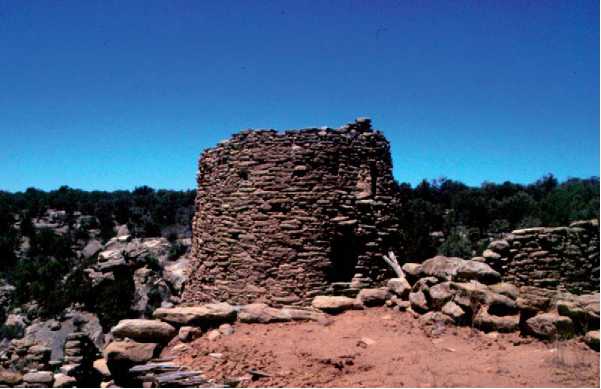The Gobernador phase (AD 1630 and 1755) was originally defined as a period of extensive Puebloan influence manifested by the influx of Pueblo refugees fleeing the Spanish Reconquest. This phase is evidenced by the presence of high numbers of northern Rio Grande and Hopi ceramics, the manufacture of Gobernador Polychrome ceramics (which resemble Puebloan ceramic styles), the construction of defensive structures or pueblitos (which resemble Puebloan architecture), and the appearance of Puebloan-style masked dancers and kachina-like figures in Navajo rock art. This evidence of Puebloan influence is augmented by historical documentation of increased Navajo-Puebloan political interaction and trade and by the presence of Puebloan groups among the Navajo following the Pueblo Revolt of 1680.
Beginning in the early 1600s, Navajos began producing a polychrome ceramic now known as Gobernador Polychrome (in addition to their characteristic utility ware, Dintitah Gray). The occurrence of this polychrome ceramic at Navajo sites is considered one of the primary temporal markers for the Gobernador phase. The similarity of Gobernador Polychrome to contemporary Puebloan polychrome vessels (e. g., Rio Grande Glaze Ware, Tewa Polychrome, and Sikyatki Polychrome) prompted early researchers to suggest that it was produced by Pueblo refugees. Considering that Gobernador Polychrome occurs at sites dating at least 50 years prior to the Pueblo Revolt, it is unlikely that it was initially produced by Pueblo refugees. The multistylistic character of Gobernador Polychrome, incorporating design styles, design layouts, and color patterning present on both Eastern and Western Pueblo pottery, further supports Navajo production and innovation. Given the social ties that probably existed between the Navajo and Pueblo and the fact that Navajo tradition acknowledges intermarriage between the two cultural groups, we recognize the potential influence resulting from a Puebloan potter marrying into a Navajo family. Nevertheless, Gobernador Polychrome ultimately represents a Navajo ceramic type produced over a period of approximately 150 years in the Dinetah region.
Along with defensive pueblitos, Gobernador phase sites exhibit a wide range of variability in habitation types. Dwellings may include any combination of forked-stick hogans, masonry-walled pueblitos, lean-tos, and ramadas. The range of site complexity for habitations is difficult to specify, but pueblito sites range from 1 to 35 rooms and may have as many as eight associated hogans. A great variety of traded ceramics is found at habitation sites, as well as at associated limited activity, non-habitation sites. These ceramics include Rio Grande Glaze Ware, Rio Grande Biscuit Ware, Jemez Black-on-white, Tewa polychromes, and Eastern Keres, Zuni, and Hopi wares. Obsidian from the Abiquiu and Jemez areas is also present.
Evidence of imported ceramics (e. g., Rio Grande Glaze Ware and Biscuit Ware, Jemez Black-on-white, Tewa Polychrome) and lithic raw materials (e. g., obsidian from the Abiquiu and Jemez, New Mexico areas) is more abundant during the Gobernador phase than during the Diniitah phase; this has been attributed both to exchange and to the presence of Pueblo refugees at Navajo pueblito sites. Gobernador phase sites contain ceramics produced by both Eastern and Western Pueblo groups. However, no archaeological data beyond the presence of trade ware ceramics and Puebloan-like architecture demonstrates that the pueblito sites were built or occupied by Pueblo refugees. The only data that support this inference are from historic Spanish documents. Figure 15 shows an Early Navajo pueblito site from the early eighteenth century.
Many researchers of Navajo archaeology and culture have focused on the acculturative processes operating during the Gobernador phase and the changes that took place in Navajo population and culture. James Hester and Joel Shiner discussing their work on Gobernador phase sites in the Navajo Reservoir in the 1960s, explained Navajo acceptance of Puebloan traits as a fusion of Puebloan and Navajo characteristics that changed Navajo culture forever. Ethnologists Bailey and Bailey echoed this theme, suggesting that Gobernador phase Navajo were biological and cultural hybrids, neither Athabascan nor Puebloan, but a product of both. As discussed above, there is little evidence to support the large-scale, permanent presence of Puebloans among the Navajo that would have been necessary to constitute a site unit intrusion and a truly hybridized culture. By contrast, we, and other researchers, explain the presence of Puebloan pottery and architecture, and the resultant influences on Navajo culture, largely as

Figure 15 Photograph of early Navajo site, Frances Canyon pueblito, northwest New Mexico. Photograph by author.
A result of interaction and diffusion, along with ‘migration’ of small numbers of Puebloans who became part of Navajo groups. The origin of at least two Navajo clans is attributed to Puebloan refugees - the Black Sheep clan (with refugees from San Felipe) and the Coyote Pass clan (with individuals from Jemez). Such an interpretation accords well with the hypothesis presented here and, again, does not provide support for a complete transformation of Navajo culture and hybridization with Puebloan culture. Rather, Navajo culture incorporated Puebloan people, ideas, and certain customs, but remained essentially Athabascan.
The entire concept and definition of the Goberna-dor phase is undergoing revision. Archaeologists Reed and Reed have discussed the evidence indicating that the manufacture of Gobernador Polychrome began as early as the 1630s in some areas, more than 60 years prior to the purported beginning of the Gobernador phase. Ron Towner’s work on the dendrochronology of the area suggested that most of the pueblito sites were not constructed until the 1720s, more than 30 years after the main exodus of Puebloan people from the Rio Grande area is assumed to have occurred. Thus, it is probably a misnomer to describe these sites as ‘refugee’ phenomena. In addition, a study of pueblito location and visibility has suggested that the pueblito system was largely a defensive response to Ute raiding that is ethnohistori-cally documented to have increased in scale and intensity after 1720. The suggestion that the construction of the pueblitos was a response to Ute pressure is not, however, new. Roy Carlson made such a suggestion in 1965 while reporting on Earl Morris’s work from the 1920s. In sum, recent work has changed our understanding of the Early Navajo Gobernador phase and the cultural evolution and history of the Navajo people.
See also: Americas, North: CaWfornia and the Sierra Nevada; Great Basin; Plains; Rocky Mountains.




 World History
World History









